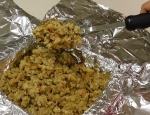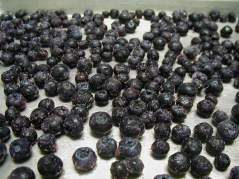 We have just finished one big U.S. holiday centered around big family meals and celebrations. What comes with those times might be a table full of leftovers. You may be happy with the way you managed the Thanksgiving leftovers or wish you had done some things better. Since another holiday season with many food-filled activities and events is upon us, I thought I would review some food safety advice for handling leftovers.
We have just finished one big U.S. holiday centered around big family meals and celebrations. What comes with those times might be a table full of leftovers. You may be happy with the way you managed the Thanksgiving leftovers or wish you had done some things better. Since another holiday season with many food-filled activities and events is upon us, I thought I would review some food safety advice for handling leftovers.
One really important task is to get the “perishable” leftovers into the refrigerator or freezer and cooling within two hours of the cooking. By perishable, I mean those foods that require cold storage to be held safely. And yes, that means conversation and games at tableside might have to be cut short for the person or people who put up the leftovers! But if someone gets sick from eating leftovers not stored safely, future good times will be cut off, too. Time-temperature abuse as well as possible post-cook contamination during the meal means even well-cooked foods can be future hazards. Cooking doesn’t remove all bacterial concerns from foods; they still have to be kept at recommended temperatures.
To get started on those leftovers, make sure you have clean hands, work surfaces like cutting boards and counters, food storage containers, and utensils. A clean apron can help protect you as well as the food you work over. It would be best to start with a clean apron and dish towels or wipes and not those you used in meal preparation and now have been sitting around dirty with food residues at room temperature themselves.
To prevent bacterial growth, it’s important that food will cool rapidly to the safe refrigerator-storage temperature of 40°F or below. For example, divide large amounts of food into shallow containers. Cut or slice roasts, hams and whole turkeys into small pieces and fill into small containers. Legs and wings can be left whole. Other larger items like big casserole dishes should be packaged in smaller portions if you have a lot leftover. It is best to separate the turkey, stuffing and gravy into separate shallow containers.
Package your leftovers in tightly sealed containers or wraps for best quality. For freezer storage, packaging should be moisture-vapor resistant materials to prevent freezer burn. Plastics should be “freezer-weight” or composition, glass jars that are meant for freezing, and all sealing areas should be tight-fitting. For freezing, be sure all sealing areas are also clean and dry and to leave recommended headspace for expansion (https://nchfp.uga.edu/how/freeze/headspace.html). Moisture left on sealing surfaces can expand when it freezes and create air gaps in your seals. Clearly label each package with the name of the food, ingredients, and packaging date. Package foods in amounts you will be likely to use at one time.
Do not overload the refrigerator or freezer with warm leftovers causing the temperature to rise above the recommended storage temperature. The small containers of your warm food can be spread out until cooled or frozen; you can then go back and stack or organize them differently if desired. A large stack of warm containers will cool more slowly, as if you had used a large container instead of many shallow ones. The refrigerator temperature should keep foods at 40°F or below, so you might need the interior cabinet temperature to be around 38°F. The best freezer air temperature should be 0°F for best food quality and storage times.
Use turkey and stuffing within 3 to 4 days for safety; gravy might be best used within 1-2 days. It is safe to refreeze leftover cooked turkey and trimmings even if you purchased them frozen. Frozen typical turkey meal leftovers are best used in 3-4 months; although safe if kept frozen longer, they start to lose noticeable quality when kept longer in the freezer.
When it’s time to enjoy the leftovers from the freezer, the safest way to thaw them is in the refrigerator. If foods are then to be reheated, reheat leftovers to at least 165°F and check the internal temperature of the thickest part with a food thermometer. Bring gravies, sauces, and soups to a rolling boil as added safety.
Food safety steps for correctly storing the turkey and trimmings are critical when preparing your favorite sandwiches, casseroles, and soups from leftovers. Avoiding illness is important so don’t take short cuts or waste time in getting to this task quickly at the end of the meal! Remember, harmful bacteria grow rapidly between the temperatures of 40°F and 140°F. Even recommended cooking temperatures can result in some bacteria still contaminating the food. Some pathogens contaminate food in a heat-resistant “spore-form that survives cooking. These spores do not make us sick if ingested in that form, but temperature abuse during serving and holding food will result in those spores germinating to forms of bacterial cells that can make us sick or even produce toxins that will make us very sick if ingested.
After food is safely cooked, enjoy your meal, but within 2 hours of cooking food or after it is removed from an appliance keeping it warm above 140°F, leftovers must be refrigerated.
Additional resource: You can see more about recommended food storage times and tips for safe preparation in the FoodKeeper.app. The database is searchable online or available as a mobile app for Android and Apple devices. (https://www.foodsafety.gov/keep/foodkeeperapp/index.html)
###

 We have just finished one big U.S. holiday centered around big family meals and celebrations. What comes with those times might be a table full of leftovers. You may be happy with the way you managed the Thanksgiving leftovers or wish you had done some things better. Since another holiday season with many food-filled activities and events is upon us, I thought I would review some food safety advice for handling leftovers.
We have just finished one big U.S. holiday centered around big family meals and celebrations. What comes with those times might be a table full of leftovers. You may be happy with the way you managed the Thanksgiving leftovers or wish you had done some things better. Since another holiday season with many food-filled activities and events is upon us, I thought I would review some food safety advice for handling leftovers.


You must be logged in to post a comment.